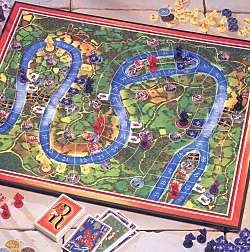

|
| Courtesy of Funagain Games |
First a brief summary of the rules. The board consists of twisty representation of the Rhine River divided into 54 segments. Each of these segments consists of a river space and a left and right rvier bank space. Players are each dealt five cards which each represent a different segment of the river and determine which spaces are available for your move. Here the amount of thinking power is immediately reduced. Rather than allowing a placement on any river segment, one has only five to choose from. A move consists of placing a knight token on either bank of the river or in the river if both banks are occupied. Alternatively, if none of the five cards suits you, a player may play adjacent to any existing knight. This is called a reinforcement move.

|
| Courtesy of KMV Spielplatz |
These are the basic rules of this rather simple game. A few remaining features are the towns, bastions, castles, and churches all represented by tokens which are placed in the duchies on the baord. Towns come in 2, 3, and 4 point varieties and simply add value to any duchy when the duchy changes hands or scores at the end of the game. Bastions are neutral blocker pieces which prevent the placement of other pieces in a space. A player may place one per turn in order to prevent the expansion of any duchy. Castles basically give a baron a free knight placement. If the duchy changes hands, the castles change hands also. Churches are somewhat like 1 point towns, except that the player with the most churches also gains control of the archbishop. The archbishop allows a player to convert an existing knight to a knight of the proper thinking. This is a very useful play because the balance of power in the duchy is swayed by two points (you add one knight, your opponent loses one) rather than the normal gain (you add one knight). The tokens for the towns, bastions, castles, and churches add flovor and excitement to the game. They are fun focal points to battle and defend. So much for the rules.
First of all, let me compare this game to Reiner Knizia's other recent tile placement games Euphrat & Tigris, Durch die Wüste, and Samurai. I would say Rheinländer is about the complexity of Durch die Wüste, namely the simplest of the lot. I never was a fan of the Samurai scoring system, so I am happy to say Rheinländer is a simple score-all-you-can endeavour. The placement of tiles and expansion of duchies is very similar to that of Euphrat & Tigris, but Rheinländer is a simple strength comparision to determine victory, whereas Euphrat & Tigris had battles in each of the four colors. Finally, the play limiting cards and the relative simplicity of the placement (one of the three river segment spaces) ensures that Rheinländer has the least thinking and the least downtime between plays. This game moves rather quickly because in most cases you can analyze your cards and your next move while others are playing.

|
| Courtesy of KMV Spielplatz |
Also enjoyable are the game graphics and the board. Some do not like the garish colors and strong graphics, but I do like it for it reminds me of some of the older board games such as Dogfight or Stratego -- very strong hues and excellent details. You can even let your eyes wander along the paths among the hills bordering the Rhine. Also enjoyable are the 25mm plastic duke figures. They look like a tiny William Shakesspeare in full plate armor. These are just screaming to be painted and weathered. The immense amount of tokens are enjoyable too -- each of the tiny shields show battle damage such as tiny sword cuts, mace hits, and weathering. The black plastic compartmental tray is a bit of overkill. Anal-retentive players will enjoy placing the shields in individual slots, but I prefer large tray compartments that can accomodate a few plastic Ziploc bags.
Strategy is a bit difficult on this one. Because of the limiting effect of five cards in hand, I would say to play by common sense. Establish as many duchies as possible early in the game. The lost duchies will pay you gold, and the surviving duchies will pay you gold in the end. Also, always attempt to play for the towns and the castles - there are free points and knights there. Go for the more immediate tactical bonuses, and be mindful to expand to enhance your long term value.
How do I think this game will hold up in the long term? Reiner Knizia fans such as myself will certainly enjoy adding this one to the collection. It has enough variety and eye-candy to distinguish itself from the other tile placement games. On the other hand, the game does feel a little dry and cerebral. Whereas other game's random elements tend to induce laughter and surprise, the randomness in this game adds no fun or surprise. Once again, it is difficult to see the value the chrome adds to the game mechanics, and the thin veneer and imagery is stretched tightly over the hard bones of an abstract game beneath. ( I believe I owe this metaphor to Mike Siggins. ) Nevertheless it is a good solid game. More mature and serious gamers will enjoy the tough decisions to be made. Younger gamers and kids-at-heart will enjoy the graphics. And I would like to encourage more of this type of game from Parker and Hasbro. Recommended.